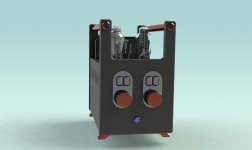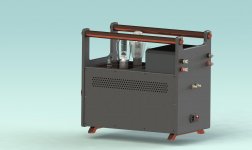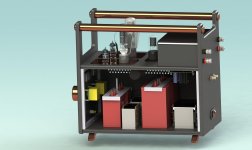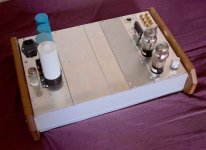I am designing a chassis for my amp and thought I'd ask if anyone is interested in getting one made for cost. It will cost less if we get a couple made and I am willing to tweek it a little to suit. Anyways I have not gotten quotes yet but I used to work as a machinist for 16 years and know alot of people. So I am hoping to get the buddy price.
anyone interested pm me.
Jeff
anyone interested pm me.
Jeff
Attachments
Won't be cheap, of course, but jwags818 has obviously prepared the CAD files already. It had a machinist job, so the CAD files will probably translate to CAM files easily (this is the most dreaded part when a designer send its creation to a machine shop). At first glance it should be a straighforward work for a laser or waterjet cutter with some further processing at the CNC machine. The most geometrically complex part seems to be the foot. This work really needs a high-end paint or surface treatment job; a generic commercial flat powder coating or anodization will ruin the end result.
This kind of design could be made quite easily from 19" sub rack parts. Just invert a 4U rack and add additional horizontal rails further down for the lower portion. Then add top plates and bottom plates which would screw into the horizontal rails with M3 or M2.5 screws depending on the rack. Add handles on either side. Could be made as smart as you wanted it with ventilated sides etc. All the parts are available from Schroff and the other sub rack makers.
I use this system myself and it's incredibly versatile. I've collected a load of horizontal rails and make my own top plates. Ideal for breadboarding - you just screw in different plates as required. If you want it wider at the top then go to 5U or 6U. 4U is a nice size, though.
I use this system myself and it's incredibly versatile. I've collected a load of horizontal rails and make my own top plates. Ideal for breadboarding - you just screw in different plates as required. If you want it wider at the top then go to 5U or 6U. 4U is a nice size, though.
Attachments
Last edited:
Yes I know very well how to design something easy to make. This is all flat plates with a little bit of sheet metal. I am guessing it will cost a couple hundred to build but I already have over $3k in my amp in parts alone so wtf?
I want it to look as nice as it sounds. Its amazing how fast the cost add up.
Almost $1k in lundahl iron, $425 in volume controls, almost $300 in tubes. I got the coupling caps at 60% off or they would have been $600 ( never would have paid that but at less than $300 a pair for Duelund cast PIO caps I did). a couple hundred more for power supply caps. Soviet PIO. All the resistors are Caddock or Vishay foils. Currently using a circuit board but will be ptp in this box. And $140 for Tent labs filament boards. I would love to hear some Western Electric tubes in it but prolly never will. I am going to have Nixie indicators for the volume knobs. Found some hollow shaft pots I can slide over the shafts of the autoformers to indicate position. The thing weighs like 85 pounds. All for 7 watts of magnificent sound... Those tent labs heater boards are worth every penny. I had a slight hum before I bought them and now with 96db spl speakers you have to put your head right against them to tell its even turned on.
Dimensions are 10 wide x 15 7/8 tall x 17 deep not counting knobs and jacks.
I want it to look as nice as it sounds. Its amazing how fast the cost add up.
Almost $1k in lundahl iron, $425 in volume controls, almost $300 in tubes. I got the coupling caps at 60% off or they would have been $600 ( never would have paid that but at less than $300 a pair for Duelund cast PIO caps I did). a couple hundred more for power supply caps. Soviet PIO. All the resistors are Caddock or Vishay foils. Currently using a circuit board but will be ptp in this box. And $140 for Tent labs filament boards. I would love to hear some Western Electric tubes in it but prolly never will. I am going to have Nixie indicators for the volume knobs. Found some hollow shaft pots I can slide over the shafts of the autoformers to indicate position. The thing weighs like 85 pounds. All for 7 watts of magnificent sound... Those tent labs heater boards are worth every penny. I had a slight hum before I bought them and now with 96db spl speakers you have to put your head right against them to tell its even turned on.
Dimensions are 10 wide x 15 7/8 tall x 17 deep not counting knobs and jacks.
Last edited by a moderator:
This kind of design could be made quite easily from 19" sub rack parts. Just invert a 4U rack and add additional horizontal rails further down for the lower portion. Then add top plates and bottom plates which would screw into the horizontal rails with M3 or M2.5 screws depending on the rack. Add handles on either side. Could be made as smart as you wanted it with ventilated sides etc. All the parts are available from Schroff and the other sub rack makers.
I use this system myself and it's incredibly versatile. I've collected a load of horizontal rails and make my own top plates. Ideal for breadboarding - you just screw in different plates as required. If you want it wider at the top then go to 5U or 6U. 4U is a nice size, though.
Very nice!!
I have gotten spoiled having access to CNC machines. Nice to see some creative solutions from those that are not as lucky. Have any pics of what you have done with that system?
Here's some pics. I've been using 2U size height and 275mm front to back for the top plates.
But I'm tempted by your "vertical" idea. Especially if I use tubes with top caps for HT I'd want them enclosed and they'd go nicely inside a vertical model.
But I'm tempted by your "vertical" idea. Especially if I use tubes with top caps for HT I'd want them enclosed and they'd go nicely inside a vertical model.
Attachments
I have an ancient 1949 (70 yr old +) Bogen amp which has a Choke input filter PSU and only 16Mf of smoothing, but lots of iron....I already have over $3k in my amp in parts alone ..
Almost $1k in lundahl iron, $425 in volume controls, almost $300 in tubes. I got the coupling caps at 60% off or they would have been $600 ( never would have paid that but at less than $300 a pair for Duelund cast PIO caps I did).
The thing weighs like 85 pounds. All for 7 watts of magnificent sound...
I had a slight hum before I bought them and now with 96db spl speakers you have to put your head right against them to tell its even turned on.
It has KT66 inside with TCs going back to the last war.
It puts out an incredibly clean 60W per monobloc and the hum is not detectable even with an ear pressed against the speaker. It's about 39kg, about the same weight as yours.
I recently designed and built a 50W per ch stereo amp, which everyone states sounds absolutely fantastic.
It was specifically designed to fit in a car, and be transportable easily as accompanied baggage on a plane flight.
With both channels paralleled it turns out a clean linear low distortion 100W and has no loop feedback, (something that a Mesa or Marshall can't actually even manage).
At idle it uses just 100W of power all in, so in effect it's 50% efficient at full power, ie. it uses the same power needs at 12V of a pair of car headlights to run it.
Without the optional flight case it weighs 13kg and is grafted into a stunning little 3U case, where no valves are visible at all. That's 29lbs folks!
You can carry it down the street and put it in a taxi to a demo.
Including the beautiful little (vintage) UTC S30H swinging choke supply, the really chunky (vintage) OPTs & the Polish toroid power transformer (cost 125E delivered...) I think those parts cost less than 500USD.
Under test, the square wave response is so linear it would make Lundahl look expensive and not so great (which is why few people use them in professional mixing desks).
It seems to be the general rule, most stuff which costs giant sums and weighs tons, usually is underwhelming and underperforming,-
eg. Jadis and their way over the top transformers which just transmit masses of distortion.
I bought my quality 3U rack mount chassis in the USA and imported them for less than 75USD. 😀
Nice design, I've been designing some "two story" case ideas too. I have a CNC router in the garage that I use for wood, it works well for aluminum sheet too. I started playing around with the thought of a two story case putting the power supply on the first floor away from everything else, with the amp hugging the "ceiling" and the OPT's sunk down halfway through to top at the rear to lower the overall height. But servicing an amp in such a case has been my biggest challenge, how do you provide easy access? Removable long sides are good, but you'd still need a tech to be able to get to the interior "ceiling" easily. How do you do that? One idea for yours here is to make the whole PS onto a slide out chassis with an umbilical where that PS chassis also forms the whole bottom panel. When servicing you'd remove both sides of the box, slide out the PS chassis, place it next to you while still "umbilicaled", flip over the whole thing onto your two top handles then easily get to the whole amp ceiling under the tubes. The two top handles you have are a nice feature in that you can flip the whole amp on the bench without having to prop up things on pieces of wood because the tubes are taller. I do like that your case can be inverted for servicing and sides removable. But if the whole bottom is removable with the PS then a tech would have full access to anything.
Last edited:
Good idea on the removable bottom. Right now I have it in 2 separate chassis and it is very nice to not have to work around so much stuff. I had it first in a large cube shaped case meant for SS amp. it really sucked working on it. Hence the move to a new chassis. I put it into two big headphone amp chassis I had laying around in the meantime.
I have an ancient 1949 (70 yr old +) Bogen amp which has a Choke input filter PSU and only 16Mf of smoothing, but lots of iron.
It has KT66 inside with TCs going back to the last war.
It puts out an incredibly clean 60W per monobloc and the hum is not detectable even with an ear pressed against the speaker. It's about 39kg, about the same weight as yours.
I recently designed and built a 50W per ch stereo amp, which everyone states sounds absolutely fantastic.
It was specifically designed to fit in a car, and be transportable easily as accompanied baggage on a plane flight.
With both channels paralleled it turns out a clean linear low distortion 100W and has no loop feedback, (something that a Mesa or Marshall can't actually even manage).
At idle it uses just 100W of power all in, so in effect it's 50% efficient at full power, ie. it uses the same power needs at 12V of a pair of car headlights to run it.
Without the optional flight case it weighs 13kg and is grafted into a stunning little 3U case, where no valves are visible at all. That's 29lbs folks!
You can carry it down the street and put it in a taxi to a demo.
Including the beautiful little (vintage) UTC S30H swinging choke supply, the really chunky (vintage) OPTs & the Polish toroid power transformer (cost 125E delivered...) I think those parts cost less than 500USD.
Under test, the square wave response is so linear it would make Lundahl look expensive and not so great (which is why few people use them in professional mixing desks).
It seems to be the general rule, most stuff which costs giant sums and weighs tons, usually is underwhelming and underperforming,-
eg. Jadis and their way over the top transformers which just transmit masses of distortion.
I bought my quality 3U rack mount chassis in the USA and imported them for less than 75USD. 😀
According to the designer performance is better than most 300B designs because of the ultra-linear driver stage and higher than normal OPT impedance (5.6k). I know it sounds really good and gets plenty loud thru the full range 12s I have. what company is your power toroidal from?
what company is your power toroidal from?
I had Toroidy make mine to order, it took 4 weeks.
In the end I had him add a lot of extra windings for all sorts of different heaters, seperate HT & bias, a la Parmeko of old, so that I could remove a number of seperate ones in one hit.
There is very little space for it, so we managed to pack it all into a 250VA core, "max punch for min space" concept.
The main winding I specified as 520V@300m/a with taps at 450 & 330 so that I could revert to capacitor input filter if I ever felt the need.
(currently it's choke input filter, with a damper diode for warm up, with si bridge rect up front of it).
The screen supply is cap input filter, run though a valve regulator, which supplies a rock steady 317V.
That was rated at 100m/a.
After being hammered flat out for hours the transformer scarcely gets warm.
I suspect the reason why Polish transformer makers are so good, they must have had a major USSR based industry there, that's certainly true of some of the Baltic states countries nearby.
Toroidy are also up in the north of Poland like Ogonowski.
Transformatory toroidalne - Producent transformatorow Toroidy.pl
contact Tomasz Lachowski
- Home
- Amplifiers
- Tubes / Valves
- Anyone interested in a custom chassis?





